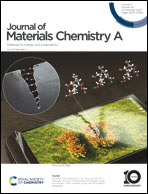Investigation of high-entropy Prussian blue analog as cathode material for aqueous sodium-ion batteries†
Abstract
Aqueous rechargeable sodium-ion batteries (ARSIBs) have received considerable attention as promising alternatives to lithium-ion batteries (LIBs) owing to their safety, environmental friendliness, low cost, and high charge/discharge capacities. Development of novel electrode materials remains a central area of research in this field. In this study, we developed a high-entropy Prussian blue analog (HEPBA) as a cathode material for ARSIBs. High-entropy doping has been confirmed to reduce water content and regulate the spin state of PBAs, thereby enhancing their electrochemical performance. DFT calculations showed that high-entropy doping considerably narrowed the bandgap of the material, decreased the difficulty of electron excitation to the conduction band, and enhanced the electron migration ability. The assembled NaTi2(PO4)3@C‖1 M Na2SO4‖HEPBA full cells exhibited better long-term cycling and rate performance than nickel hexacyanoferrate with a capacity of 75 mA h g−1 at 0.5C and a retention rate of 87% after 1000 cycles at 1C. Even at a high rate of 10C, the full cells achieved an initial capacity of 57.1 mA h g−1 and a remaining capacity of 47.4 mA h g−1 after 5000 cycles.

- This article is part of the themed collection: #MyFirstJMCA


 Please wait while we load your content...
Please wait while we load your content...